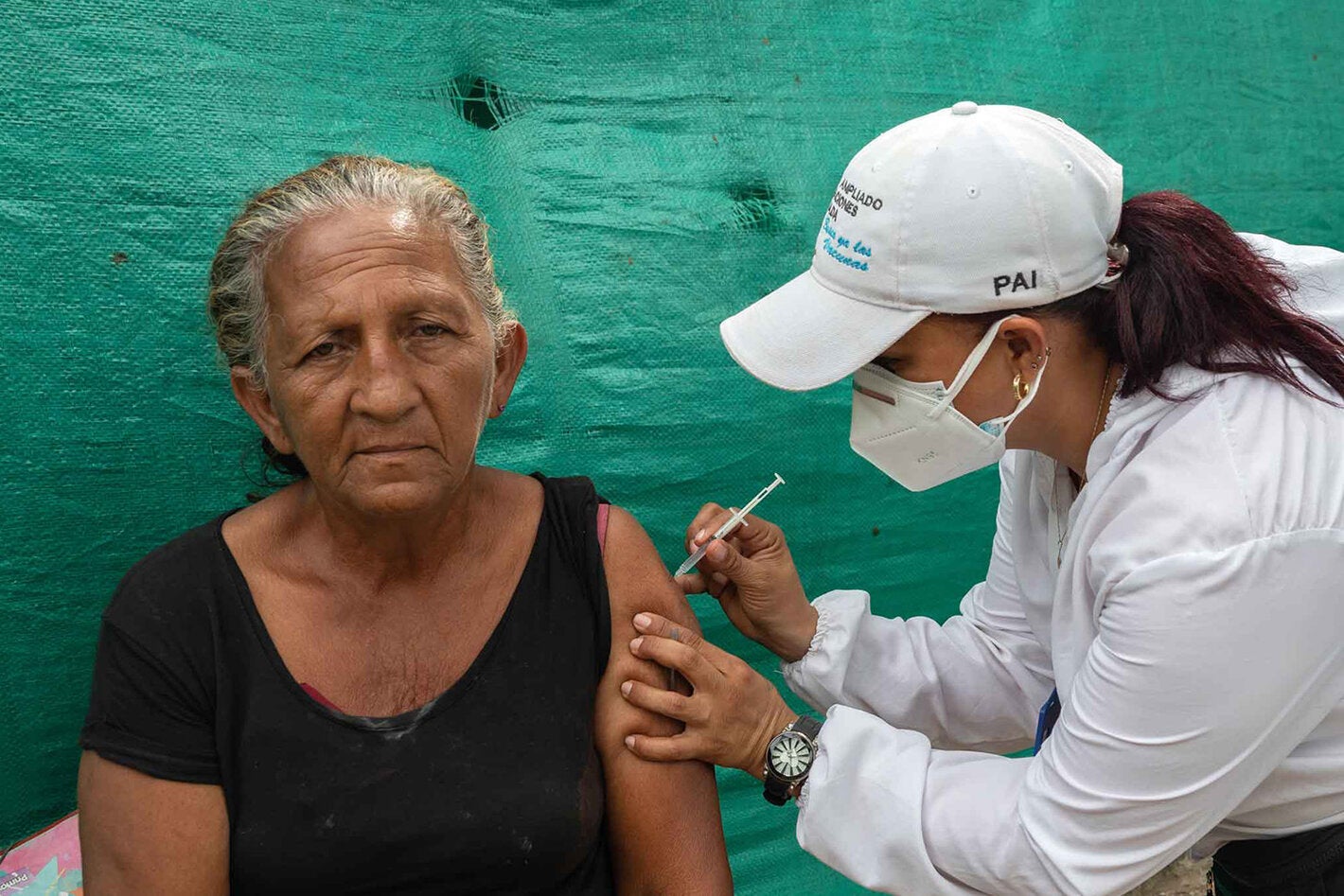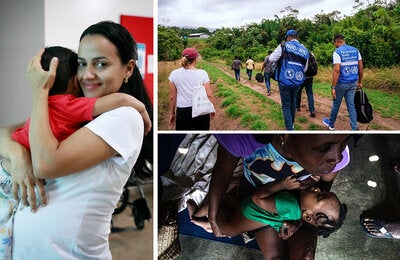
Geneva, 28 March 2023 (WHO) – Following its 20-23 March meeting, WHO’s Strategic Advisory Group of Experts on Immunization (SAGE) revised the roadmap for prioritizing the use of COVID-19 vaccines, to reflect the impact of Omicron and high population-level immunity due to infection and vaccination.
The roadmap continues SAGE’s prioritization of protecting populations at the greatest risk of death and severe disease from SARS-CoV-2 infection and its focus on maintaining resilient health systems. The roadmap newly considers the cost-effectiveness of COVID-19 vaccination for those at lower risk – namely healthy children and adolescents – compared to other health interventions. The roadmap also includes revised recommendations on additional booster doses and the spacing of boosters. The current COVID-19 vaccines’ reduction of post-COVID conditions is also considered but the evidence on the extent of their impact is inconsistent.
“Updated to reflect that much of the population is either vaccinated or previously infected with COVID-19, or both, the revised roadmap reemphasizes the importance of vaccinating those still at-risk of severe disease, mostly older adults and those with underlying conditions, including with additional boosters,” stated SAGE Chair Dr Hanna Nohynek. “Countries should consider their specific context in deciding whether to continue vaccinating low risk groups, like healthy children and adolescents, while not compromising the routine vaccines that are so crucial for the health and well-being of this age group.”
The revised roadmap outlines three priority-use groups for COVID-19 vaccination: high, medium, and low. These priority groups are principally based on risk of severe disease and death, and consider vaccine performance, cost-effectiveness, programmatic factors and community acceptance.
The high priority group includes older adults; younger adults with significant comorbidities (e.g. diabetes and heart disease); people with immunocompromising conditions (e.g. people living with HIV and transplant recipients), including children aged 6 months and older; pregnant persons; and frontline health workers.
For the high priority group, SAGE recommends an additional booster of either 6 or 12 months after the last dose, with the timeframe depending on factors such as age and immunocompromising conditions. All the COVID-19 vaccine recommendations are time-limited, applying for the current epidemiological scenario only, and so the additional booster recommendations should not be seen as for continued annual COVID-19 vaccine boosters. The aim is to serve countries planning for the near- to mid-term.
The medium priority group includes healthy adults – usually under the age of 50-60 – without comorbidities and children and adolescents with comorbidities. SAGE recommends primary series and first booster doses for the medium priority group. Although additional boosters are safe for this group, SAGE does not routinely recommend them, given the comparatively low public health returns.
The low priority group includes healthy children and adolescents aged 6 months to 17 years. Primary and booster doses are safe and effective in children and adolescents. However, considering the low burden of disease, SAGE urges countries considering vaccination of this age group to base their decisions on contextual factors, such as the disease burden, cost effectiveness, and other health or programmatic priorities and opportunity costs.
The public health impact of vaccinating healthy children and adolescents is comparatively much lower than the established benefits of traditional essential vaccines for children – such as the rotavirus, measles, and pneumococcal conjugate vaccines – and of COVID-19 vaccines for high and medium priority groups. Children with immunocompromising conditions and comorbidities do face a higher risk of severe COVID-19, so are included in the high and medium priority groups respectively.
Though low overall, the burden of severe COVID-19 in infants under 6 months is still higher than in children aged 6 months to 5 years. Vaccinating pregnant persons – including with an additional dose if more than 6 months have passed since the last dose – protects both them and the fetus, while helping to reduce the likelihood of hospitalization of infants for COVID-19.
Countries that already have a policy in place for additional boosters should assess the evolving need based on national disease burden, cost effectiveness and opportunity costs.
Separate to the roadmap, SAGE also updated their recommendations on bivalent COVID-19 vaccines, now recommending that countries can consider using BA.5 bivalent mRNA vaccine for the primary series.
Other meeting highlights include:
Polio
SAGE evaluated the data on the novel oral polio vaccine type 2, recommending that it should be the preferred choice for response to circulating vaccine-derived poliovirus type 2 (cVDPV2) wherever possible. It also recommended that to rapidly boost immunity levels in hard to reach or conflict-prone areas, the interval between vaccines can be as low as 1 week, compared to the regular 4-week interval.
In areas of persistent poliovirus circulation, SAGE recommended that countries supplement outbreak response with additional campaigns using inactivated polio vaccines (full or fractional doses).
Regional reports on measles
The increase in the size and number of measles outbreaks exemplifies the repercussions of the pandemic's seismic impact on routine immunization. In 2021, coverage with the first dose of measles vaccine was at its lowest level since 2008, with 25 million children missing out.
With measles cases increasing in all WHO regions in 2022, challenges include difficulties with delivering vaccines in conflict-affected settings, weak health systems, competing priorities, and inadequate financing. Surveillance quality declined globally during the pandemic, although there are signs of recovery in several countries.
SAGE noted the need to review policies on age eligibility for measles vaccination to enable catch-up, accelerate the development and use of new technologies and innovations, and review the evidence for vaccination of infants below six months and during pregnancy.
Status of new tuberculosis vaccines
Tuberculosis (TB) is a leading cause of death and a vaccine that prevents disease in adolescents and adults is urgently needed. A substantial effort for vaccine development is underway, with several candidates in late-stage clinical trials and the potential for multiple vaccines to receive regulatory authorization within 3 years.
A process has been initiated to systematically determine research evidence needs that will allow for vaccines policy and vaccine introduction decisions. In this context, SAGE made proposals to build the evidence base regarding a promising TB vaccine candidate for adults and adolescents, M72/AS01E.
Malaria
Introducing the RTS,S malaria vaccine has resulted in a substantial reduction in severe malaria and all-cause mortality among age eligible children. There is high demand for the vaccine, with at least 28 countries expressing interest in introducing the vaccine. Of these, 15 countries have already submitted a formal application for support to Gavi, and more than 15 additional applications are expected later this year. Supply remains highly constrained. SAGE recommends flexibility in the immunization schedule and supports reducing the minimum interval between doses 3 and 4 to 6 months to optimize impact.
Identifying priority pathogens for new vaccines
WHO is in the process of defining regional priority targets for new vaccine development for non-epidemic pathogens. Early results indicate that tuberculosis, HIV, and pathogens that exhibit high levels of antimicrobial resistance (e.g. Klebsiella pneumoniae) are important across all regions. Streptococcus pyogenes (Group A streptococcus), Shigella, and respiratory syncytial virus (RSV) were identified as important by 4 or more regions, as was Plasmodium falciparum by the African region.



